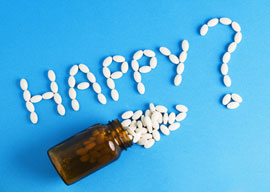
July 10, 2013

Source: Shutterstock
Aldous Huxley’s 1932 dystopian novel Brave New World depicts an ideal pleasure drug, a hangover-free tranquilizer called soma that the totalitarian government freely distributed daily. The opiate-like drug dulled the senses and, happily for the government, pacified the masses. Everybody loved soma as an easy escape from any dissatisfaction. One excerpt sums it all up:
By this time the soma had begun to work. Eyes shone, cheeks were flushed, the inner light of universal benevolence broke out on every face in happy, friendly smiles. Even Bernard felt himself a little melted.
In case you haven”t noticed, American society is slowly inching toward soma and, as in Brave New World, the embrace is both popular and government facilitated. No, we are not talking about legalizing pot or the CIA allegedly pushing crack in the “hood. Pharmacologically speaking, everything is FDA-approved.
Since 1988 the use of antidepressant drugs is up 400%, according to the Centers for Disease Control. They are the most popular drug for those between 18 and 44. One in four women aged 40 to 59 takes them. The recent economic downturn has supposedly made antidepressants the escape of choice to deal with unemployment, home foreclosures, and similar economic tribulations.
Actually, the data on antidepressant use among women is only part of the story. Millions of American women are becoming winos. Nearly 650,000 women follow “Moms Who Need Wine“ on Facebook and, according to a wine industry trade group, women buy and drink most of the 800 million gallons of wine annually consumed in the US. (Their DUIs have also soared while the figures for men remain stable.)
Critically, everything points to increased use of drugs to deaden the senses. For one, the stigma of fighting off “the blues” by taking pills has long vanished. Social pressure now encourages “doing something” about anxiety or despair, and “something” rarely embraces traditional solutions such as religion. Then there are TV ads showing (typically) unhappy middle-aged women being energized thanks to the sponsor’s antidepressant. The commercial inevitably ends with “See your doctor and ask him about…” and “If you cannot afford a prescription, we can help.”
Antidepressants have also evolved into a socially permissible tactic promoting overall mental well-being apart from curing clinical depression. They are a one-a-day vitamin for the brain that can boost self-confidence while improving job performance. The best-selling book Listening to Prozac has been interpreted to suggest that antidepressants are an easy, no-risk recipe for bliss that is no different (and a lot more convenient) than daily exercise.
Finally, cost-conscious insurance companies love pills. Who needs years of $250-an-hour psychotherapy sessions when a cheap generic antidepressant will suffice? As the patents to these drugs expire, instant happiness will cost twenty-five cents a day or less.
Paralleling antidepressant usage is the explosive growth in drugging troublesome children. The Centers for Disease Control and Prevention estimate that the number of children diagnosed with Attention Deficit Hyperactivity Disorder (ADHD) has increased by 16% since 2007. Some six million children aged 4 to 17 allegedly now suffer from ADHD, including one in five high-school males. How are these children to be treated? Simple: Drug them with the amphetamines Ritalin or Adderall.
It certainly takes less effort to send a disorderly student to the school nurse for medication than to impose discipline, and no teacher risks rebuke by medicating common classroom problems. Similarly, it’s more acceptable for parents to explain junior’s lackluster academic performance with “He suffers from ADHD” than to admit he’s not very smart. In fact, armed with an official ADHD determination, a pushy parent can get junior some extra time for his exams or school-paid extra tutoring, all of it part of the larger disability movement.